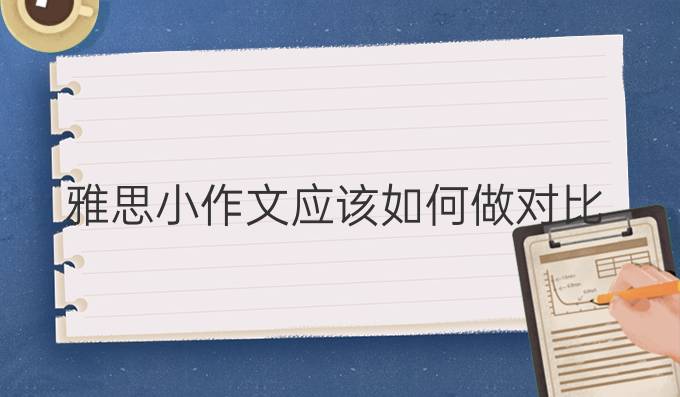雅思小作文如何做对比?正在准备雅思写作的学生可以一起来看看下面的介绍,希望能对大家的雅思写作考试成绩*带来帮助。
1.数值大与小的比较
在同时期比较两个事物的数值时,例如,表达A大B小,常常用表示对比的连词while将两句话连接起来,并且在while后面的B事物前加上much more或者much less一类的比较级,以突出B的小,跟A做对比。例如:
Lamb and chicken were eaten in similar quantities (around150grams), while much less fish was consumed (justover50grams).
(剑七Test2)
或者B事物前加用only来表示数值很小,又例如:
…nuclear power,..., had developed into the main source, producing almost 75% of electricity, at 126 units, while coal and oil together produced only 50 units.
(剑七Test4)
变化幅度的大小也能够被类似的句式表达,比如:
The consumption of fish also declined, but much less significantly to just below 50 grams,
(剑七Test2)
2.增长与减少的比较
这也是段落内部十分常见的对比方式。先描述A下降或上升了,然后用while或者类似的连词连接后面的B上升或下降了;同时,这种比较也适用于段落之间,比如正文的一个主体段写A,B和C都上升了,下一个主体段写D下降了。需要注意的是,如果是段落间的比较,则不适合用while,而应该用In contrast, Conversely, on the other hand一类表示意群对比的句首词。例如:
The consumption of chicken, on the other hand, showed an upward trend,…
(剑七Test2,作为一段的首句,说明前面一段写的是其他几种肉类的消费量都下降了。)
段落内部的比较还是可以放心大胆的用while,例如:
However, while the figures for the Western countries grew to about 15% in around 1990, the figure for Japan dippedtoonly 2.5% for much of this period,…
(剑五Test1)
上述就是雅思小作文对比技巧解析,希望大家在实践中尽量使用上述技巧,更好的备考。
雅思写作中如何使句型多样化
词汇和句型的使用是雅思写作*的关键点之一,那么雅思写作中如何使句型多样化?本文就相关的信息做整理,希望可以供大家参考。
关键词:
雅思写作中如何使句型多样化,雅思写作句型
如果雅思写作中句子清一色是简单句,文章必定很单调乏味。如果全篇充满了冗长的复杂句,读起来也很费力。那么雅思写作中如何使句型多样化?
在雅思写作学习当中,*好的方法是以简单句为基础,配合适当的并列句和复杂句。简单句可长可短,通常要加些附属成分,如分词短语、介词短语、副词短语、不定式动词短语,以及节缩成分。总之,雅思写作技巧作者可根据情况,使句子多样化,使文章灵活多姿。例如下列五个句子的基本概念一样,但是句式不同,内容重点也有些差别:
(1) The goats grazed peacefully in the farm and were unaware of the approaching hunter. (并列分句(1)+2)
(2) Grazing peacefully, the goats in the farm were unaware of the approaching hunter. (现在分语短语+简单句)
(3) In the farm, the goats grazed peacefully and were unaware of the approaching hunter. (副词短语+并列分句(1)-(2) )
(4) There were goats grazing peacefully in the farm, unaware of the approaching hunter. (简单句+形容语短语)
(5) As the goats grazed peacefully in the farm, they were unaware of the approaching hunter. (原因副词从句+主句)
(1)和(5)的句式*常见;如果加上其他三种互相交替,句子不是更多样化吗?*后,看看这两个句子要如何多样化呢?
(6) The young pilot was on his first overseas training.
(7) He felt very uneasy.
(a) The young pilot on his first overseas training felt very uneasy.
(b) The young pilot felt very uneasy during his first overseas training.
(c) The young pilot's first overseas training made him feel very uneasy.
(d) Extreme uneasiness seized the young pilot on his first overseas training.
(e) The young pilot was on his first overseas training, feeling very uneasy.
(f) It being his first overseas training, the young pilot felt very uneasy.
(g) Being on his first overseas training, the young pilot felt very uneasy.
(h) The young pilot was on his first overseas training and felt very uneasy.
(i) The young pilot, who was on his first overseas training, felt very uneasy.
(j) When the young pilot was on his/first overseas trainging, he felt very uneasy.
(k) As the young pilot was on his first overseas training, he felt very uneasy.
(l) The young pilot was on his first overseas training, so that he felt very uneasy.
在上述12个句子中,(a)-(g)是简单句;(h)是并列句;(i)-(l)是复杂句。简单句除(b)和(g)之外,其他五样,用的人并不多。人们*喜欢采用复杂句,尤其是(j)和(k)这两款;接着便是并列句(h)。如果大多数人的句子只限于(b),(g), (h), (j)和(k)这五种,而其他的则弃如敝屣,不是很可惜

 沪公网安备31010102007649号
图书经营许可证:第A7651号
版权所有:上海朗阁教育科技股份有限公司 Copyright 2005 LONGRE EDUCATION GROUP All Rights Reserved
沪公网安备31010102007649号
图书经营许可证:第A7651号
版权所有:上海朗阁教育科技股份有限公司 Copyright 2005 LONGRE EDUCATION GROUP All Rights Reserved